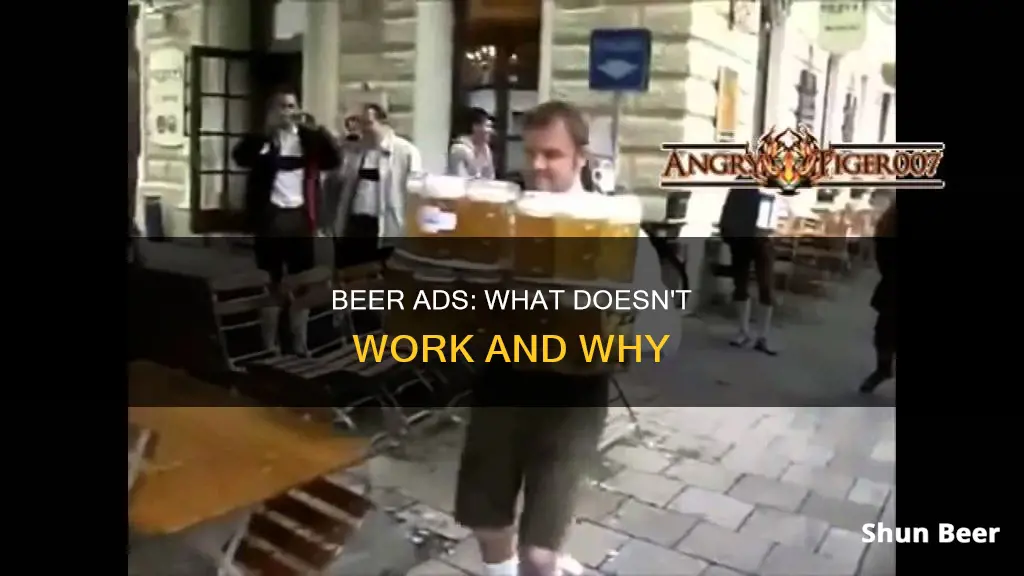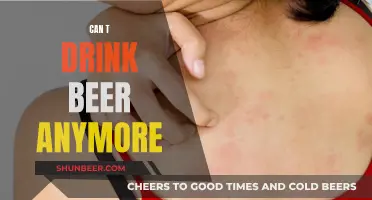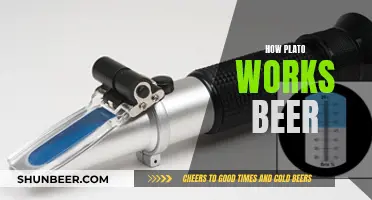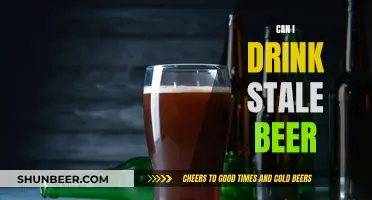
Beer commercials have long been a staple of advertising, with some campaigns such as Budweiser's Whassup and Wazzup becoming embedded in popular culture. However, the effectiveness of beer commercials is being called into question, with some arguing that they no longer resonate with modern audiences and are failing to keep up with changing trends in the alcohol industry and entertainment landscape.
One reason for the decline in beer commercials' influence could be the shift in media consumption, with younger audiences spending more time on streaming services and digital platforms than traditional TV. Beer companies have been slow to adapt to these changes, continuing to invest heavily in TV advertising despite the older demographics it attracts.
Additionally, there has been a noticeable shift in the tone of beer commercials. Once dominated by light-hearted and humorous campaigns, beer ads have become increasingly sombre and emotional, potentially failing to connect with their target audience in the same way.
Furthermore, the self-regulation of the alcohol industry and the voluntary nature of advertising guidelines have led to inconsistent messaging and a lack of legal repercussions for non-compliance, which may contribute to the ineffectiveness of some beer commercials.
| Characteristics | Values |
|---|---|
| Beer commercials don't show people drinking beer | This is due to an unofficial agreement between advertisers and TV networks, not a legal requirement. |
| Decline in beer commercials | Between 2019 and 2021, beer TV commercial minutes on major US networks declined by 18%, and airings declined by 4%. |
| Shift to digital advertising | Beer companies are increasingly advertising on digital platforms such as YouTube and TikTok, and in the metaverse. |
| Target audience | The target audience for beer commercials is young, legal-drinking-age consumers, but the audience for traditional TV is getting older. |
| Effectiveness of TV advertising | It is difficult to measure the impact of commercials on sales, and there is a perception that TV advertising is becoming less effective. |
| Cost of TV advertising | TV advertising is becoming more expensive, and beer companies are spending hundreds of millions of dollars annually on TV ads. |
| Competition for ad space | Beer companies face competition for ad space from other industries, such as insurance and prescription drugs, which are also targeting older demographics. |
What You'll Learn

Beer commercials don't show consumption, which may reduce their effectiveness
The absence of alcohol consumption in beer commercials may reduce their effectiveness for several reasons. Firstly, it may detract from the enjoyment and fun typically associated with beer commercials. By not showing people drinking and enjoying the product, the commercials may seem less relatable and engaging to viewers.
Secondly, the absence of consumption may make it challenging for viewers to understand the purpose of the commercial. If the product is not being consumed, it can be difficult for viewers to grasp the intended use and benefits of the beer being advertised. This can lead to a disconnect between the commercial and the target audience, potentially reducing its impact and effectiveness.
Additionally, the lack of consumption in beer commercials can make it challenging to establish a clear call to action. Effective advertising often involves creating a sense of urgency or desire in the viewer, prompting them to take action, such as purchasing the product. By not showing consumption, beer commercials may struggle to convey a compelling reason for viewers to try the product.
Finally, the absence of consumption can make it difficult for beer commercials to stand out and differentiate themselves from other advertisements. With a limited time frame, typically 30 seconds, beer commercials need to capture attention and leave a lasting impression. By not showing consumption, they may fail to create a unique and memorable connection with the audience, potentially reducing their overall effectiveness.
Do Beer Cozies Work? The Science Behind It
You may want to see also

Beer commercials are losing popularity to insurance ads
The tone of beer commercials has changed significantly over the years. In the '80s and '90s, beer commercials featured talking frogs, animated beer bottles, and catchy slogans. However, in recent years, these ads have become more subdued and emotional, like Anheuser-Busch's "Let's Grab a Beer" campaign. On the other hand, insurance ads have embraced humour and creativity, with memorable characters like the GEICO Gecko, Flo from Progressive, and the Aflac Duck. These fun and lighthearted commercials have resonated with viewers, making insurance companies stand out in a highly competitive market.
The COVID-19 pandemic also played a role in the shift. Anheuser-Busch, a major brewery, opted against running commercials during the Super Bowl in 2021, instead donating their marketing budget to COVID-19 vaccination awareness efforts. This decision by a prominent industry player likely influenced the overall decrease in beer commercials.
Additionally, insurance companies have recognized the importance of investing heavily in advertising to improve brand recall and attract new customers. They understand that insurance is not a glamorous or exciting product, so they use creative strategies and memorable characters to engage consumers. This shift towards investing in advertising is reflected in the significant increase in insurance ad airings and the corresponding decrease in beer commercials.
While some may argue that insurance ads are less appealing or effective, the numbers suggest otherwise. The increased airtime and creative approaches used by insurance companies have contributed to their growing popularity. Beer commercials, on the other hand, seem to be losing their appeal, especially among younger audiences. To reconnect with consumers, beer companies may need to revisit their advertising strategies and find new ways to engage their target market.
Thermal Beer Mugs: How Do They Keep Drinks Cold?
You may want to see also

Beer commercials are not evolving with the times
The target demographic for beer is young, legal-drinking-age consumers, who are increasingly spending more time on digital platforms like YouTube, TikTok, and streaming services rather than traditional TV. Beer companies have been slow to adapt to these changes, continuing to pour money into TV ads, particularly for live sporting events. This is partly due to the influence of distributors, who want to see that beer companies are investing money in a brand through splashy national TV campaigns. However, this strategy is becoming less effective as the audience for traditional TV gets older and smaller.
In addition, the tone of beer commercials has shifted dramatically in recent years. In the '80s and '90s, beer commercials were known for their lighthearted and humorous approach, with talking frogs, Spuds MacKenzie, and the iconic "Wazzup" campaign. Today, beer commercials have become increasingly somber and earnest, with campaigns like Anheuser-Busch's "Let's Grab a Beer" striking a much softer tone. This shift away from humor has been criticized by advertising experts, who argue that beer companies have forgotten that advertising is about "recruiting the young and impressionable" and making friends for the brand.
While beer commercials were once at the forefront of pop culture, they are now struggling to keep up with the changing landscape of the alcohol industry and the evolving preferences of consumers. To remain relevant, beer companies will need to evolve their advertising strategies and embrace newer digital platforms and integrated advertising approaches.
Understanding Beer Pumps: The Inner Workings Explained
You may want to see also

Beer commercials are not funny anymore
Beer commercials have been a staple of American television for decades, with their catchy slogans and memorable characters. However, in recent years, there has been a noticeable shift in the tone and frequency of these advertisements, leading many to believe that beer commercials are not funny anymore. So, what has changed?
The Decline of Beer Commercials
The number of beer commercials on television has been steadily declining. Between 2019 and 2021, beer TV commercial minutes on major sports networks decreased by 18%, while airings declined by 4%. This is a significant drop, especially considering that beer companies still allocate a large portion of their advertising budgets to TV commercials. The question arises: why are beer commercials on the decline?
Changing Landscape of Advertising
One reason for the decline could be the changing landscape of advertising. With the rise of digital platforms and streaming services, traditional TV viewership is decreasing, especially among younger audiences. Beer's target demographic, young legal-drinking-age consumers, are spending more time on online platforms like YouTube, TikTok, and streaming services. This shift in media consumption has led to a corresponding shift in advertising strategies, with companies allocating more of their budgets to digital advertising.
The Impact of the Pandemic
The COVID-19 pandemic also played a role in the decline of beer commercials. During the pandemic, many beer companies chose to pause or reduce their advertising efforts, opting instead to donate their marketing funds to COVID-19 vaccination awareness campaigns. This pause in advertising may have contributed to the overall decline in beer commercial airings.
A Shift in Tone
Not only have the number of beer commercials decreased, but the tone of the advertisements has also changed. In the 1980s and 1990s, beer commercials were known for their lighthearted and humorous approach, with iconic campaigns such as "Wazzup" and the Budweiser frogs. However, in recent years, beer commercials have become increasingly somber and emotional. Campaigns like Anheuser-Busch's "Let's Grab a Beer" from 2021 struck a much softer tone compared to the funny and playful commercials of the past.
Self-Regulation and Drinking on Screen
Another factor that may be influencing the content of beer commercials is the self-regulation within the alcohol industry. While there are no government regulations preventing the portrayal of drinking in commercials, the industry has long-standing guidelines that recommend against showing alcohol consumption. These guidelines, which date back to the end of prohibition, are followed by television agencies and advertisers to avoid any potential moral backlash from viewers. As a result, beer commercials rarely show actors actually drinking beer, which can limit the comedic potential of these advertisements.
In conclusion, the decline in the number of beer commercials, coupled with a shift in tone towards more serious and emotional content, has led to the perception that beer commercials are not funny anymore. While the changing landscape of advertising and the impact of the pandemic have played a role, the self-regulation within the industry and the avoidance of depicting drinking on screen may be significant factors in the changing nature of beer commercials.
Mouthwash Beer Spray: Effective Mosquito Repellent?
You may want to see also

Beer commercials are not reaching the right audience
Beer commercials are facing a decline in viewership, and this is partly because they are not reaching the right audience. The target demographic for beer is young, legal-drinking-age consumers. However, the average age of a live TV viewer is increasing, and this demographic is spending more time on YouTube, TikTok, and streaming services.
In the past, beer commercials were a staple of TV advertising, with iconic campaigns such as Budweiser's "Whassup" and Miller Lite's "Tastes Great, Less Filling". These commercials were so successful that they became embedded in popular culture, with the former even making a comeback during the pandemic in 2020.
However, the landscape of entertainment and alcohol sales has shifted towards digital and online platforms. The rise of e-commerce and streaming services has resulted in a decline in traditional TV viewing, especially among the younger demographic. This shift in media consumption has been accelerated by the pandemic, which compressed 10 years of e-commerce growth for alcohol into just three months.
As a result, beer commercials are struggling to keep up with the changing pace of the alcohol industry. While beer companies still spend hundreds of millions of dollars annually on TV ads, they are facing a decrease in both the number of commercials aired and the number of people watching them. This is reflected in the data, which shows a decline in beer commercial minutes and airings on major networks.
To adapt to this changing landscape, beer companies need to explore newer, digital platforms and embrace integrated ads or product placements that cannot be skipped or ignored. As Hope Schau, a professor of marketing, notes, "Beer is resting on their laurels...They don’t want to change, because that was their heyday."
Understanding Beer Siphons: How Do They Work?
You may want to see also
Frequently asked questions
Beer commercials are not as effective as they once were because they are still relying on TV advertising, which is becoming less relevant for beer as the audience gets older. Beer commercials are also not embracing newer, digital platforms.
Beer commercials have become increasingly sombre and have given up on humour. They now emphasise emotional connections and fitness, which may not be as appealing to younger audiences.
The "Let's Grab a Beer" campaign by Anheuser-Busch and the Bud Light "Dilly Dilly" spot are examples of recent beer commercials that failed to capture the public imagination in the same way as earlier campaigns such as Budweiser's "Whassup" ads.







